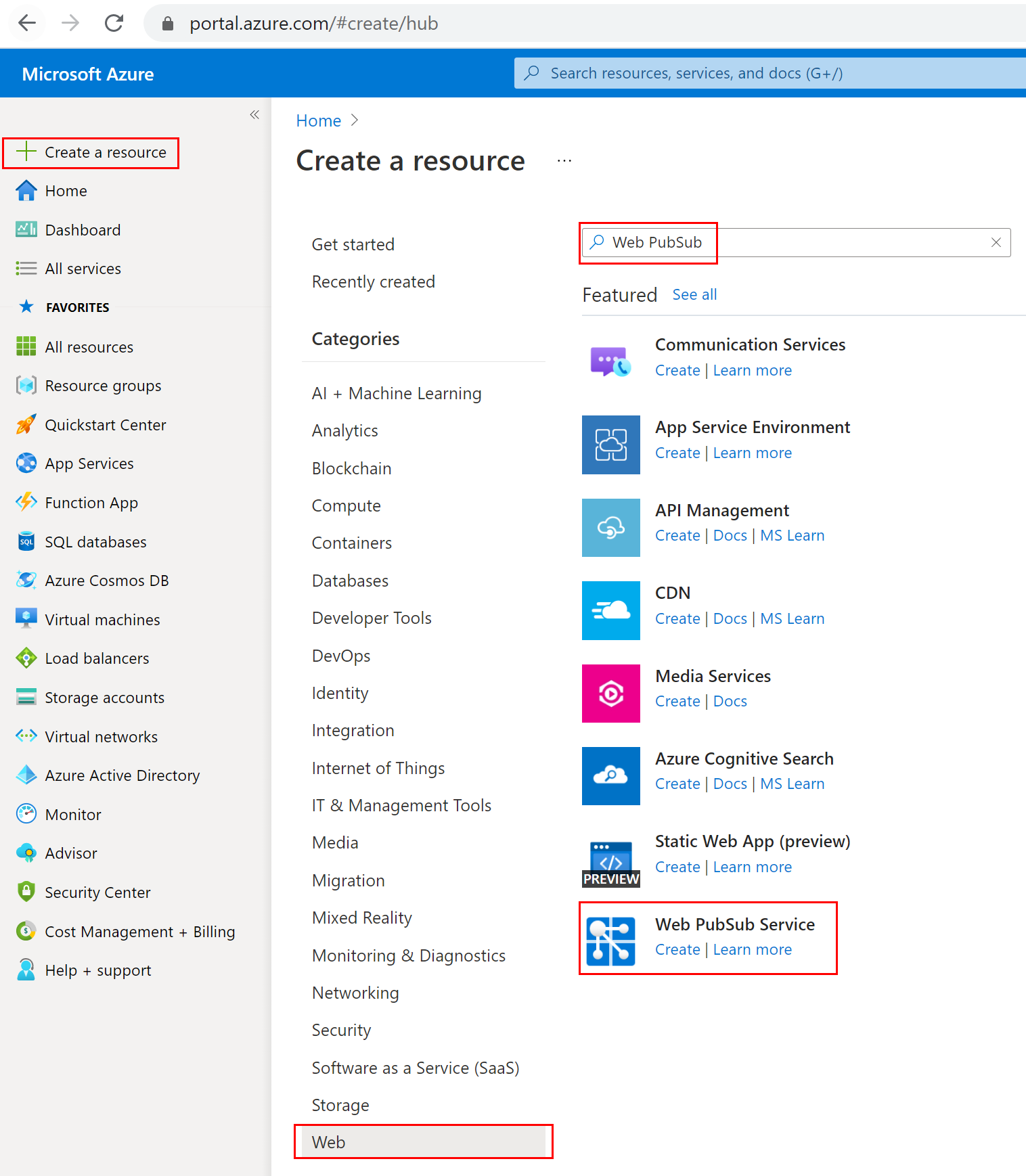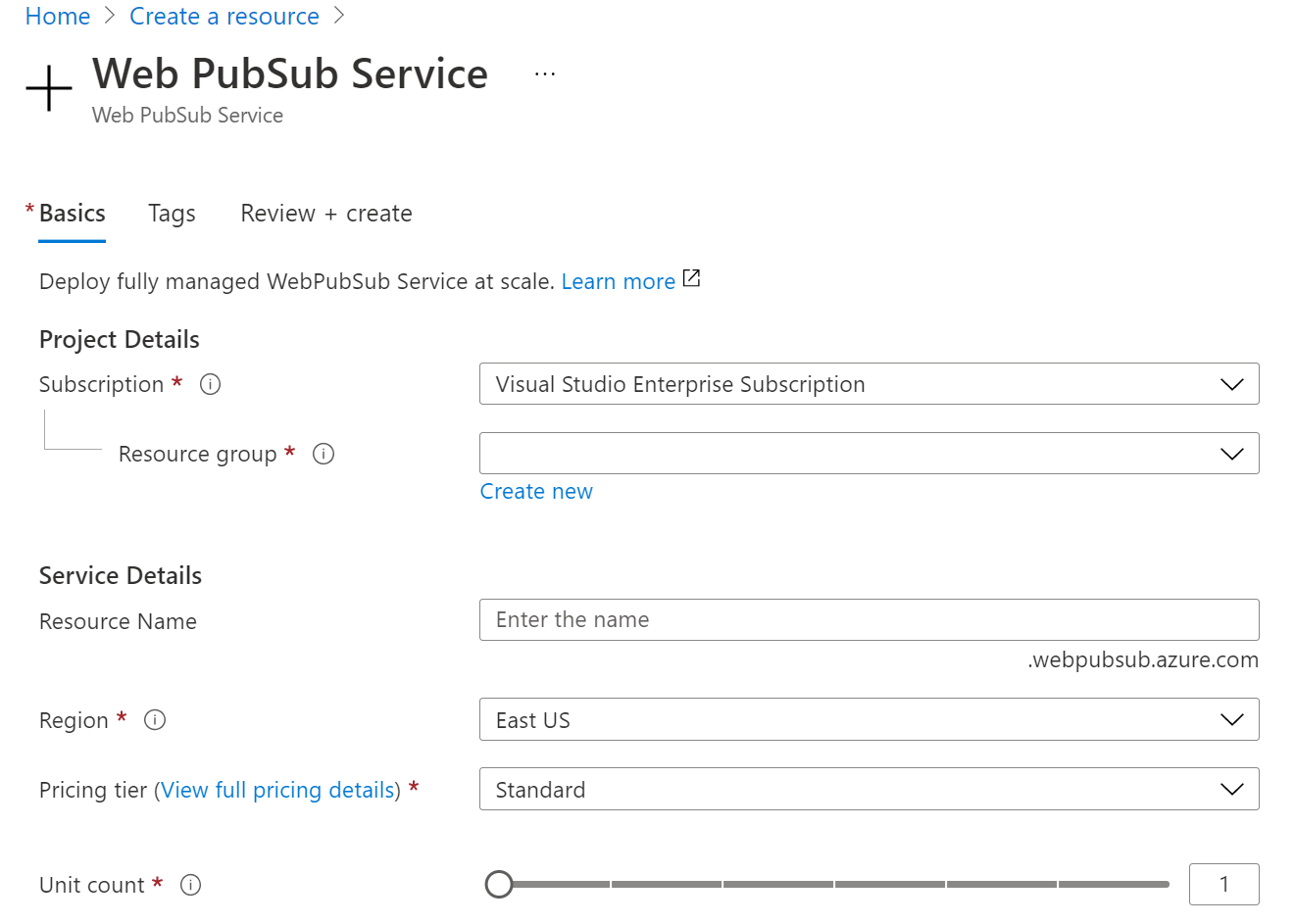Azure Web PubSub サービスは、WebSocket を使用して、リアルタイム メッセージング Web アプリケーションを作成するのに役立ちます。 Azure Functions は、インフラストラクチャを管理することなくコードを実行できるサーバーレス プラットフォームです。 このチュートリアルでは、Azure Web PubSub サービスと Azure Functions を使用して、通知シナリオでリアルタイム メッセージングを使用したサーバーレス アプリケーションを作成する方法について説明します。
このチュートリアルでは、以下の内容を学習します。
- サーバーレス通知アプリを作成する
- Web PubSub 関数の入力および出力のバインドを使用する
- サンプル関数をローカルで実行する
- 関数を Azure Function App にデプロイする
重要
この記事に示す生の接続文字列は、デモンストレーションのみを目的としています。
接続文字列には、アプリケーションが Azure Web PubSub サービスにアクセスするために必要な認可情報が含まれています。 接続文字列内のアクセス キーは、サービスのルート パスワードに似ています。 運用環境では、常にアクセス キーを保護してください。 Azure Key Vault を使ってキーの管理とローテーションを安全に行い、WebPubSubServiceClient を使って接続をセキュリティ保護します。
アクセス キーを他のユーザーに配布したり、ハードコーディングしたり、他のユーザーがアクセスできるプレーンテキストで保存したりしないでください。 キーが侵害された可能性があると思われる場合は、キーをローテーションしてください。
前提条件
Azure アカウントをお持ちでない場合は、開始する前に無料アカウントを作成してください。
Azure へのサインイン
Azure アカウントで Azure Portal (https://portal.azure.com/) にサインインします。
Azure Web PubSub サービス インスタンスを作成する
アプリケーションは Azure 内の Web PubSub サービス インスタンスに接続します。
Azure portal の左上にある [新規] ボタンを選択します。 [新規] 画面で、検索ボックスに「Web PubSub」と入力して Enter キーを押します。 (Azure Web PubSub を Web カテゴリから検索することもできます)。

検索結果の [Web PubSub] を選択し、 [作成] を選択します。
次の設定を入力します。
| 設定 |
提案された値 |
説明 |
|
リソース名 |
グローバルに一意の名前 |
新しい Web PubSub サービス インスタンスを識別するグローバルで一意の名前。 有効な文字は、a-z、A-Z、0-9、- です。 |
|
サブスクリプション |
該当するサブスクリプション |
この新しい Web PubSub インスタンスが作成される Azure サブスクリプション。 |
|
リソース グループ |
マイリソースグループ |
Web PubSub サービス インスタンスの作成先となる新しいリソース グループの名前。 |
|
場所 |
米国西部 |
近くのリージョンを選択します。 |
|
[価格レベル] |
Free |
まず Azure Web PubSub サービスを無料でお試しいただけます。
Azure Web PubSub サービスの価格レベルの詳細をご覧ください。 |
|
[ユニット数] |
- |
ユニット数は、Web PubSub サービス インスタンスで受け入れることができる接続の数を指定します。 各ユニットで最大 1,000 のコンカレント接続がサポートされます。 Standard レベルでのみ構成可能です。 |

[作成] を選択して Web PubSub サービス インスタンスのデプロイを開始します。
関数をローカルで作成して実行する
Azure Functions Core Tools がインストールされていることを確認します。 次に、プロジェクト用の空のディレクトリを作成します。 この作業ディレクトリの下でコマンドを実行します。 以下のオプションのいずれかを使用します。
func init --worker-runtime javascript --model V4
func init --worker-runtime javascript --model V3
func init --worker-runtime dotnet
func init --worker-runtime dotnet-isolated
func init --worker-runtime python --model V1
手順に従って Microsoft.Azure.WebJobs.Extensions.WebPubSub をインストールします。
Web PubSub サポートを受けるには、host.json の extensionBundle がバージョン 4.* 以降であることを確認または更新します。
host.json を更新するには、エディターでファイルを開き、既存のバージョンの extensionBundle をバージョン 4.* 以降に置き換えます。
{
"extensionBundle": {
"id": "Microsoft.Azure.Functions.ExtensionBundle",
"version": "[4.*, 5.0.0)"
}
}
Web PubSub サポートを受けるには、host.json の extensionBundle がバージョン 3.3.0 以降であることを確認または更新します。
host.json を更新するには、エディターでファイルを開き、既存のバージョンの extensionBundle をバージョン 3.3.0 以降に置き換えます。
{
"extensionBundle": {
"id": "Microsoft.Azure.Functions.ExtensionBundle",
"version": "[3.3.*, 4.0.0)"
}
}
dotnet add package Microsoft.Azure.WebJobs.Extensions.WebPubSub
dotnet add package Microsoft.Azure.Functions.Worker.Extensions.WebPubSub --prerelease
host.json の extensionBundle をバージョン 3.3.0 以降に更新し、Web PubSub サポートを取得します。
host.json を更新するには、エディターでファイルを開き、既存のバージョンの extensionBundle をバージョン 3.3.0 以降に置き換えます。
{
"extensionBundle": {
"id": "Microsoft.Azure.Functions.ExtensionBundle",
"version": "[3.3.*, 4.0.0)"
}
}
クライアントの静的 Web ページを読み取ってホストする index 関数を作成します。
func new -n index -t HttpTrigger
-
src/functions/index.js を更新して次のコードをコピーします。
const { app } = require('@azure/functions');
const { readFile } = require('fs/promises');
app.http('index', {
methods: ['GET', 'POST'],
authLevel: 'anonymous',
handler: async (context) => {
const content = await readFile('index.html', 'utf8', (err, data) => {
if (err) {
context.err(err)
return
}
});
return {
status: 200,
headers: {
'Content-Type': 'text/html'
},
body: content,
};
}
});
-
index/function.json を更新して次の json コードをコピーします。
{
"bindings": [
{
"authLevel": "anonymous",
"type": "httpTrigger",
"direction": "in",
"name": "req",
"methods": [
"get",
"post"
]
},
{
"type": "http",
"direction": "out",
"name": "res"
}
]
}
-
index/index.js を更新して次のコードをコピーします。
var fs = require('fs');
var path = require('path');
module.exports = function (context, req) {
var index = context.executionContext.functionDirectory + '/../index.html';
context.log("index.html path: " + index);
fs.readFile(index, 'utf8', function (err, data) {
if (err) {
console.log(err);
context.done(err);
}
context.res = {
status: 200,
headers: {
'Content-Type': 'text/html'
},
body: data
};
context.done();
});
}
-
index.cs を更新して Run 関数を次のコードに置き換えます。
[FunctionName("index")]
public static IActionResult Run([HttpTrigger(AuthorizationLevel.Anonymous)] HttpRequest req, ExecutionContext context, ILogger log)
{
var indexFile = Path.Combine(context.FunctionAppDirectory, "index.html");
log.LogInformation($"index.html path: {indexFile}.");
return new ContentResult
{
Content = File.ReadAllText(indexFile),
ContentType = "text/html",
};
}
-
index.cs を更新して Run 関数を次のコードに置き換えます。
[Function("index")]
public HttpResponseData Run([HttpTrigger(AuthorizationLevel.Anonymous, "get", "post")] HttpRequestData req, FunctionContext context)
{
var path = Path.Combine(context.FunctionDefinition.PathToAssembly, "../index.html");
_logger.LogInformation($"index.html path: {path}.");
var response = req.CreateResponse();
response.WriteString(File.ReadAllText(path));
response.Headers.Add("Content-Type", "text/html");
return response;
}
-
index/function.json を更新して次の json コードをコピーします。
{
"scriptFile": "__init__.py",
"bindings": [
{
"authLevel": "anonymous",
"type": "httpTrigger",
"direction": "in",
"name": "req",
"methods": [
"get",
"post"
]
},
{
"type": "http",
"direction": "out",
"name": "$return"
}
]
}
-
index/__init__.py を更新して次のコードをコピーします。
import os
import azure.functions as func
def main(req: func.HttpRequest) -> func.HttpResponse:
f = open(os.path.dirname(os.path.realpath(__file__)) + '/../index.html')
return func.HttpResponse(f.read(), mimetype='text/html')
クライアントがアクセス トークンを含むサービス接続 URL を取得するのに役立つ negotiate 関数を作成します。
func new -n negotiate -t HttpTrigger
-
src/functions/negotiate.js を更新して次のコードをコピーします。
const { app, input } = require('@azure/functions');
const connection = input.generic({
type: 'webPubSubConnection',
name: 'connection',
hub: 'notification'
});
app.http('negotiate', {
methods: ['GET', 'POST'],
authLevel: 'anonymous',
extraInputs: [connection],
handler: async (request, context) => {
return { body: JSON.stringify(context.extraInputs.get('connection')) };
},
});
-
negotiate/function.json を更新して次の json コードをコピーします。
{
"bindings": [
{
"authLevel": "anonymous",
"type": "httpTrigger",
"direction": "in",
"name": "req"
},
{
"type": "http",
"direction": "out",
"name": "res"
},
{
"type": "webPubSubConnection",
"name": "connection",
"hub": "notification",
"direction": "in"
}
]
}
- フォルダー negotiate を作成し、
negotiate/index.js を更新して次のコードをコピーします。
module.exports = function (context, req, connection) {
context.res = { body: connection };
context.done();
};
-
negotiate.cs を更新して Run 関数を次のコードに置き換えます。
[FunctionName("negotiate")]
public static WebPubSubConnection Run(
[HttpTrigger(AuthorizationLevel.Anonymous, "get", "post", Route = null)] HttpRequest req,
[WebPubSubConnection(Hub = "notification")] WebPubSubConnection connection,
ILogger log)
{
log.LogInformation("Connecting...");
return connection;
}
- ヘッダーに
using ステートメントを追加し、必要な依存関係を解決します。
using Microsoft.Azure.WebJobs.Extensions.WebPubSub;
-
negotiate.cs を更新して Run 関数を次のコードに置き換えます。
[Function("negotiate")]
public HttpResponseData Run([HttpTrigger(AuthorizationLevel.Anonymous, "get", "post")] HttpRequestData req,
[WebPubSubConnectionInput(Hub = "notification")] WebPubSubConnection connectionInfo)
{
var response = req.CreateResponse(HttpStatusCode.OK);
response.WriteAsJsonAsync(connectionInfo);
return response;
}
- フォルダー negotiate を作成し、
negotiate/function.json を更新して次の json コードをコピーします。
{
"scriptFile": "__init__.py",
"bindings": [
{
"authLevel": "anonymous",
"type": "httpTrigger",
"direction": "in",
"name": "req"
},
{
"type": "http",
"direction": "out",
"name": "$return"
},
{
"type": "webPubSubConnection",
"name": "connection",
"hub": "notification",
"direction": "in"
}
]
}
-
negotiate/__init__.py を更新して次のコードをコピーします。
import logging
import azure.functions as func
def main(req: func.HttpRequest, connection) -> func.HttpResponse:
return func.HttpResponse(connection)
notification を使用して通知を生成する TimerTrigger 関数を作成します。
func new -n notification -t TimerTrigger
-
src/functions/notification.js を更新して次のコードをコピーします。
const { app, output } = require('@azure/functions');
const wpsAction = output.generic({
type: 'webPubSub',
name: 'action',
hub: 'notification'
});
app.timer('notification', {
schedule: "*/10 * * * * *",
extraOutputs: [wpsAction],
handler: (myTimer, context) => {
context.extraOutputs.set(wpsAction, {
actionName: 'sendToAll',
data: `[DateTime: ${new Date()}] Temperature: ${getValue(22, 1)}\xB0C, Humidity: ${getValue(40, 2)}%`,
dataType: 'text',
});
},
});
function getValue(baseNum, floatNum) {
return (baseNum + 2 * floatNum * (Math.random() - 0.5)).toFixed(3);
}
-
notification/function.json を更新して次の json コードをコピーします。
{
"bindings": [
{
"name": "myTimer",
"type": "timerTrigger",
"direction": "in",
"schedule": "*/10 * * * * *"
},
{
"type": "webPubSub",
"name": "actions",
"hub": "notification",
"direction": "out"
}
]
}
-
notification/index.js を更新して次のコードをコピーします。
module.exports = function (context, myTimer) {
context.bindings.actions = {
"actionName": "sendToAll",
"data": `[DateTime: ${new Date()}] Temperature: ${getValue(22, 1)}\xB0C, Humidity: ${getValue(40, 2)}%`,
"dataType": "text"
}
context.done();
};
function getValue(baseNum, floatNum) {
return (baseNum + 2 * floatNum * (Math.random() - 0.5)).toFixed(3);
}
-
notification.cs を更新して Run 関数を次のコードに置き換えます。
[FunctionName("notification")]
public static async Task Run([TimerTrigger("*/10 * * * * *")]TimerInfo myTimer, ILogger log,
[WebPubSub(Hub = "notification")] IAsyncCollector<WebPubSubAction> actions)
{
await actions.AddAsync(new SendToAllAction
{
Data = BinaryData.FromString($"[DateTime: {DateTime.Now}] Temperature: {GetValue(23, 1)}{'\xB0'}C, Humidity: {GetValue(40, 2)}%"),
DataType = WebPubSubDataType.Text
});
}
private static string GetValue(double baseNum, double floatNum)
{
var rng = new Random();
var value = baseNum + floatNum * 2 * (rng.NextDouble() - 0.5);
return value.ToString("0.000");
}
- ヘッダーに
using ステートメントを追加し、必要な依存関係を解決します。
using System.Threading.Tasks;
using Microsoft.Azure.WebJobs.Extensions.WebPubSub;
using Microsoft.Azure.WebPubSub.Common;
-
notification.cs を更新して Run 関数を次のコードに置き換えます。
[Function("notification")]
[WebPubSubOutput(Hub = "notification")]
public SendToAllAction Run([TimerTrigger("*/10 * * * * *")] MyInfo myTimer)
{
return new SendToAllAction
{
Data = BinaryData.FromString($"[DateTime: {DateTime.Now}] Temperature: {GetValue(23, 1)}{'\xB0'}C, Humidity: {GetValue(40, 2)}%"),
DataType = WebPubSubDataType.Text
};
}
private static string GetValue(double baseNum, double floatNum)
{
var rng = new Random();
var value = baseNum + floatNum * 2 * (rng.NextDouble() - 0.5);
return value.ToString("0.000");
}
- フォルダー notification を作成し、
notification/function.json を更新して次の json コードをコピーします。
{
"scriptFile": "__init__.py",
"bindings": [
{
"name": "myTimer",
"type": "timerTrigger",
"direction": "in",
"schedule": "*/10 * * * * *"
},
{
"type": "webPubSub",
"name": "actions",
"hub": "notification",
"direction": "out"
}
]
}
-
notification/__init__.py を更新して次のコードをコピーします。
import datetime
import random
import json
import azure.functions as func
def main(myTimer: func.TimerRequest, actions: func.Out[str]) -> None:
time = datetime.datetime.now().strftime("%A %d-%b-%Y %H:%M:%S")
actions.set(json.dumps({
'actionName': 'sendToAll',
'data': '\x5B DateTime: {0} \x5D Temperature: {1:.3f} \xB0C, Humidity: {2:.3f} \x25'.format(time, 22 + 2 * (random.random() - 0.5), 44 + 4 * (random.random() - 0.5)),
'dataType': 'text'
}))
プロジェクトのルート フォルダーにクライアントのシングル ページ index.html を追加し、コンテンツをコピーします。
<html>
<body>
<h1>Azure Web PubSub Notification</h1>
<div id="messages"></div>
<script>
(async function () {
let messages = document.querySelector('#messages');
let res = await fetch(`${window.location.origin}/api/negotiate`);
let url = await res.json();
let ws = new WebSocket(url.url);
ws.onopen = () => console.log('connected');
ws.onmessage = event => {
let m = document.createElement('p');
m.innerText = event.data;
messages.appendChild(m);
};
})();
</script>
</body>
</html>
C# プロジェクトではファイルが別の出力フォルダーにコンパイルされるため、コンテンツ ページがそれに対応するように *.csproj を更新する必要があります。
<ItemGroup>
<None Update="index.html">
<CopyToOutputDirectory>PreserveNewest</CopyToOutputDirectory>
</None>
</ItemGroup>
C# プロジェクトではファイルが別の出力フォルダーにコンパイルされるため、コンテンツ ページがそれに対応するように *.csproj を更新する必要があります。
<ItemGroup>
<None Update="index.html">
<CopyToOutputDirectory>PreserveNewest</CopyToOutputDirectory>
</None>
</ItemGroup>
Azure Function アプリを構成して実行する
この記事に示す生の接続文字列は、デモンストレーションのみを目的としています。 運用環境では、常にアクセス キーを保護してください。 Azure Key Vault を使ってキーの管理とローテーションを安全に行い、WebPubSubServiceClient を使って接続をセキュリティ保護します。
- ブラウザーで Azure portal を開き、先ほどデプロイした Web PubSub サービス インスタンスが正常に作成されていることを確認します。 そのインスタンスに移動します。
-
[キー] を選択し、接続文字列をコピーします。

関数フォルダーでコマンドを実行して、サービス接続文字列を設定します。
<connection-string> を、必要に応じて自分の値に置き換えます。
func settings add WebPubSubConnectionString "<connection-string>"
注
このサンプルで使用している TimerTrigger には Azure Storage への依存関係がありますが、Function がローカルで実行されているときは、ローカル ストレージ エミュレーターを使用することができます。
There was an error performing a read operation on the Blob Storage Secret Repository. Please ensure the 'AzureWebJobsStorage' connection string is valid. のようなエラーが発生した場合は、Storage Emulator をダウンロードして有効にする必要があります。
これで、ローカル関数をコマンドで実行できます。
func start --port 7071
実行中のログを確認するには、http://localhost:7071/api/index にアクセスしてローカル ホストの静的ページにアクセスします。
注
一部のブラウザーでは、間違った URL に至る https に自動的にリダイレクトされます。 レンダリングが成功しない場合は、Edge を使用して URL を再確認することをお勧めします。
Azure に関数アプリをデプロイする
関数コードを Azure にデプロイする前に、3 つのリソースを作成する必要があります。
- リソース グループ。関連リソースの論理コンテナーです。
- ストレージ アカウント。関数についての情報 (状態など) を維持する目的で使用されます。
- 関数アプリ。関数コードを実行するための環境となります。 関数アプリは、ローカルの関数プロジェクトと対応関係にあります。これを使用すると、リソースの管理、デプロイ、共有を容易にするための論理ユニットとして関数をグループ化できます。
以下のコマンドを使用してこれらの項目を作成します。
Azure にサインインします。
az login
リソース グループを作成します。または、Azure Web PubSub サービスのいずれかを再利用してスキップできます。
az group create -n WebPubSubFunction -l <REGION>
リソース グループとリージョン内に汎用ストレージ アカウントを作成します。
az storage account create -n <STORAGE_NAME> -l <REGION> -g WebPubSubFunction
Azure に関数アプリを作成します。
az functionapp create --resource-group WebPubSubFunction --consumption-plan-location <REGION> --runtime node --runtime-version 18 --functions-version 4 --name <FUNCIONAPP_NAME> --storage-account <STORAGE_NAME>
az functionapp create --resource-group WebPubSubFunction --consumption-plan-location <REGION> --runtime node --runtime-version 18 --functions-version 4 --name <FUNCIONAPP_NAME> --storage-account <STORAGE_NAME>
az functionapp create --resource-group WebPubSubFunction --consumption-plan-location <REGION> --runtime dotnet --functions-version 4 --name <FUNCIONAPP_NAME> --storage-account <STORAGE_NAME>
az functionapp create --resource-group WebPubSubFunction --consumption-plan-location <REGION> --runtime dotnet-isolated --functions-version 4 --name <FUNCIONAPP_NAME> --storage-account <STORAGE_NAME>
az functionapp create --resource-group WebPubSubFunction --consumption-plan-location <REGION> --runtime python --runtime-version 3.9 --functions-version 4 --name <FUNCIONAPP_NAME> --os-type linux --storage-account <STORAGE_NAME>
Azure に関数プロジェクトをデプロイする:
Azure で関数アプリを作成したら、func azure functionapp publish コマンドを使用してローカル関数プロジェクトを配置することができます。
func azure functionapp publish <FUNCIONAPP_NAME> --publish-local-settings
注
ここでは、ローカル設定 local.settings.json をコマンド パラメーター --publish-local-settings と共にデプロイしています。 Microsoft Azure ストレージ エミュレーターを使用している場合は、プロンプト メッセージ no に続いて「App setting AzureWebJobsStorage is different between azure and local.settings.json, Would you like to overwrite value in azure? [yes/no/show]」と入力して、 Azure でこの値の上書きをスキップできます。 さらに、Function App の設定を [Azure portal] ->[設定] ->[構成] で更新できます。
これで、URL (https://<FUNCIONAPP_NAME>.azurewebsites.net/api/index) に移動して、Azure Function App から自分のサイトを確認できます。
リソースをクリーンアップする
このアプリの使用を続けない場合は、次の手順に従って、このドキュメントで作成したすべてのリソースを削除して、課金が発生しないようにします。
Azure Portal の左端で [リソース グループ] を選択し、作成したリソース グループを選択します。 代わりに、検索ボックスを使用して、名前でリソース グループを検索します。
表示されたウィンドウでリソース グループを選択し、 [リソース グループの削除] を選択します。
新しいウィンドウで、削除するリソース グループの名前を入力し、 [削除] を選択します。
次のステップ
このクイックスタートでは、サーバーレス チャット アプリケーションを実行する方法について説明しました。 これで、独自のアプリケーションの作成を始められます。


